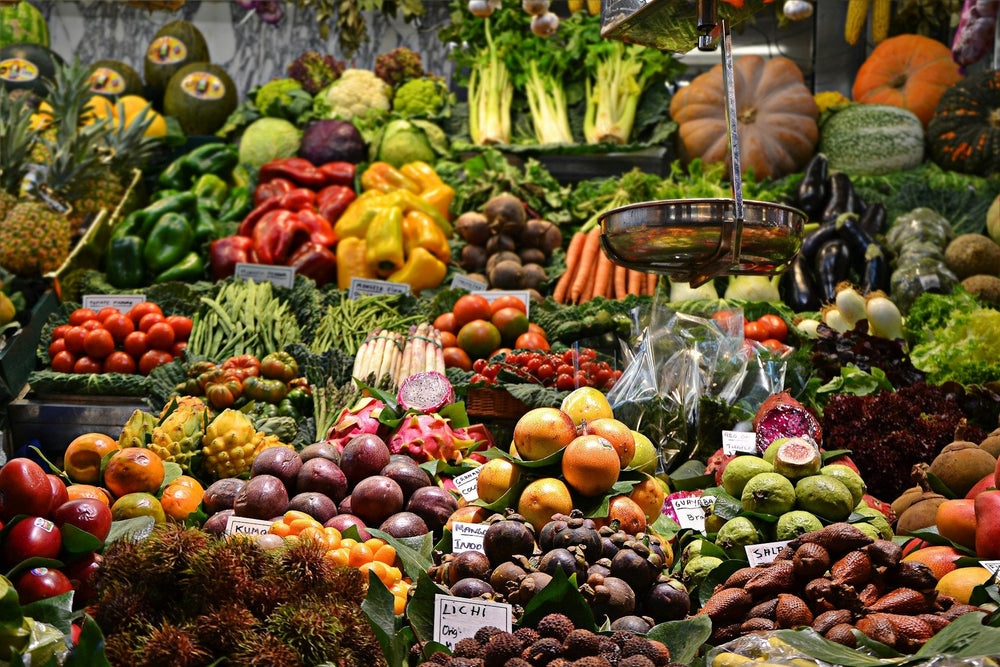
The Most Satiating Foods: What to Eat to Feel Full Longer
Feeling hungry an hour after eating can be frustrating. The good news is, some foods are naturally better at keeping you satisfied than others. Thanks to their protein, fiber, water, or healthy fat content, these foods slow digestion and help steady your energy. In fact, researchers have even measured this effect through something called the Satiety Index, which shows how filling different foods are.
Let’s look at the most satiating foods in each category and how to use them to build meals that leave you comfortably full.
What Makes a Food Satiating?
Before we dive into the most satiating foods, let’s explore what factors actually make some foods more satiating than others.
Foods that make you feel full may feature:
-
High protein and fiber – Multiple studies suggest that foods high in protein and fiber make people feel fuller for longer. Fiber can be especially filling—foods high in dietary fiber can even support gastrointestinal health.
-
High volume and low calorie density – Low energy density (LED) foods are low in calories. While it might seem like LED foods wouldn’t be filling, the opposite is true: Studies suggest that LED foods can make you feel satiated because they feature higher water content and a higher ratio of macronutrients (carbohydrates, proteins, and fats).
-
Healthy fats – Studies show that monounsaturated fats (found in foods like avocados and nuts) and polyunsaturated fats (found in fish and some vegetable oils) could slow digestion and potentially trigger the release of hormones that tell our bodies we’re full.
How do scientists know all of this? While many studies have explored individual foods and macronutrient profiles (and their impacts on fullness and hunger), a 1995 study published in the European Journal of Clinical Nutrition serves as the foundational text for much of satiety science.
The study, “A Satiety Index of Common Foods,” (informally called “The Satiety Index”) recorded how study participants responded to individual food items. Items that made participants feel full for a long time received high Satiety Index (SI) scores; foods that didn’t hold participants over received lower SI scores.
Most Satiating Foods by Category
Instead of listing all of the satiating foods studied in the Satiety Index, let’s group them into the categories above: protein-rich foods, fiber-dense foods, foods with a low calorie density, and sources of healthy fats.
#1 Protein-Rich Foods
Many protein-rich foods are meat-based. Examples include:
-
Seafood
-
Poultry
-
Chicken
-
Turkey
-
Duck
-
Red meats
-
Beef
-
Venison
-
Pork
-
Eggs
In addition, many dairy products are also high in protein, including:
-
Greek yogurt
-
Cheese
-
Cottage cheese
-
Kefir
Vegetarians and vegans, have no fear: Plant-based proteins are also widely available. Some examples include:
-
Legumes
-
Beans
-
Lentils
-
Peas
-
Peanuts
-
Soy products (like tofu)
-
Nuts and seeds
-
Grains
-
Quinoa
-
Buckwheat
-
Rice
-
Wheat gluten products (like seitan)
But which of these options is the most satiating? The Satiety Index ranks the following protein items from highest to lowest SI score (i.e., most to least filling):
-
Fish
-
Steak
-
Baked beans
-
Eggs
-
Cheese
-
Lentils
While the Satiety Index study didn’t include all of the protein-rich foods available, it does help us identify general trends: Meat-based products seem to be generally more filling than dairy and plant-based products.
#2 Fiber-Packed Foods
We typically associate the word “superfood” with items like quinoa, leafy greens, and berries. But one nutrient often goes overlooked when we talk about foods with potential positive impacts on health.
Fiber.
Why does fiber belong in the superfood category?
-
It’s filling – Fiber may make you feel fuller for longer—and the original Satiety Index study supports this hypothesis. Some of the highest-scoring foods in the study are high in fiber: potatoes, oatmeal, popcorn, and oranges, for example.
-
It could have health benefits – Health experts suggest that fiber could help reduce cholesterol levels, regulate blood sugar, and support overall gastrointestinal health.
The following fiber-rich foods certainly belong on any superfood list—and they could help you stay fuller for longer:
-
Whole grains
-
Popcorn
-
Oats
-
Barley
-
Legumes
-
Chickpeas
-
Lentils
-
Beans
-
Vegetables
-
Artichokes
-
Brussels sprouts
-
Squash
-
Broccoli
-
Carrots
-
Potatoes
-
Fruits with skin or pulp
-
Guava
-
Raspberries
-
Pears
-
Citrus
-
Apples
The Satiety Index ranks the following fiber-rich items from highest to lowest SI score:
-
Potatoes
-
Oatmeal
-
Popcorn
-
Oranges
-
Apples
-
Bran cereals
-
Whole grain pasta
#3 High-Volume, Low-Calorie Foods
Low-energy-density (LED) foods have two potential benefits:
-
At higher volumes, they may help you stay fuller for longer.
-
They’re filling, but not calorie-dense, making them ideal for people with weight loss goals.
What makes a food have LED? Experts suggest that LED foods typically have one of the following characteristics:
-
High water content – Incorporating water into a meal could increase satiety, according to a study published in Clinical Nutrition Research. Thus, water-rich foods (like asparagus, lettuce, and strawberries) fall into the LED category.
-
High fiber content – As we explored in the last section, fiber can increase satiety. But, since insoluble fiber isn’t digested by the body, it’s low-calorie.
-
Low fat content – Fat is the most energy-dense macronutrient. While healthy fats can be filling (more on that in the next section), they’re typically not low-calorie.
Case in point? Potatoes, ranked as the most satiating food on the Satiety Index, have:
-
5 grams of dietary fiber per serving (20% of the daily recommended value)
-
0 grams of fat
Other high-volume, low-calorie foods include:
-
Popcorn
-
Broth-based soups
-
Water-rich fruits and vegetables
-
Baby carrots
-
Broccoli
-
Cabbage
-
Celery
-
Cucumbers
-
Strawberries
-
Watermelon
#4 Healthy Fat Sources
Depending on your specific dietary needs and lifestyle, you may opt to choose foods with higher fat content to increase your satiety. While these typically won’t be low-calorie, they share some similarities with fiber-rich foods:
-
They’re satiating – When we ingest healthy fats, our bodies release satiety hormones: chemical signals that tell our brains we’re full.
-
They could offer health benefits – Both monounsaturated and polyunsaturated fats could help reduce cholesterol, regulate blood sugar, and manage inflammation.
Sources of healthy fats include:
-
Avocadoes
-
Nuts
-
Almonds
-
Walnuts
-
Pistachios
-
Seeds
-
Chia
-
Flax
-
Pumpkin
-
Fatty fish
-
Salmon
-
Mackerel
-
Olive oils
How to Build Satiating Meals
While you’re unlikely to eat some of the above items by themselves, you can use them to build filling meals. Satiating meals typically contain:
-
A high-protein ingredient
-
A fiber-rich food
-
A serving of healthy fats
Consider the following examples:
-
Greek yogurt fruit and nut parfait – Greek yogurt is high in protein, fruits are fiber-rich, and some nuts contain healthy fats.
-
Lentil and vegetable soup – Lentils are both fiber- and protein-rich, vegetables are particularly high in fiber, and sauteing vegetables in olive oil can introduce healthy fat content.
-
Salmon with roasted potatoes and greens – Salmon is high in both protein and healthy fats, and potatoes and greens are both fiber-rich, not to mention that potatoes are highly satiating.
Lifestyle and Eating Habits That Support Satiety
When it comes to satiety, habits are just as important as food choices. The following behaviors may help you feel fuller for longer:
-
Eating slowly and mindfully – Taking smaller, slower bites can help you identify hunger and satiety signals, helping you tune into your body’s needs.
-
Choosing whole foods over processed snacks – Generally speaking, whole foods are more nutritious and filling than packaged snacks.
-
Staying hydrated – Drinking water before eating can increase satiety—so can eating water-rich foods like fruits and vegetables.
-
Eating regular meals – Setting and maintaining a regular schedule of meals and snacks can prevent sudden hunger spikes and help you eat more intentionally.
While some foods are certainly more satiating than others, mindful eating habits also play a significant role in satiety.
Feel Fuller, Longer With Maximum Vibrance
Choosing more filling foods doesn’t mean giving up flavor or variety. With the right mix of proteins, fibers, healthy fats, and high-volume foods, your meals can work harder for you. Try experimenting with different combinations, pay attention to what keeps you satisfied the longest, and enjoy the comfort of knowing your food is actually doing its job.
One easy way to support your satiety goals? Add a nutrient-dense greens powder, like Maximum Vibrance from Vibrant Health. Packed with plant-based protein, fiber, and 25 billion probiotics, it’s a smart addition to any satiating meal or snack.

Why Trust Vibrant Health?
At Vibrant Health, we’ve been pioneers in science-backed nutrition for over 30 years, formulating transparently sourced superfood supplements that prioritize real results. Our blog is an extension of that commitment—a trusted resource for expert-driven wellness insights.
Every article is crafted with nutrition expertise, backed by the latest scientific research, and reviewed by our in-house Certified Health Coaches and Product Educators. We break down complex health topics into practical, actionable advice—helping you make informed choices about superfoods, supplementation, and holistic wellness.As a brand that has earned thousands of 5-star reviews and the trust of health professionals, we ensure that our content reflects the same quality, integrity, and transparency as our products.
Your wellness journey deserves accurate, credible, and empowering guidance. That’s why Vibrant Health’s blog is here—to help you live a healthier, more vibrant life, backed by real expertise


